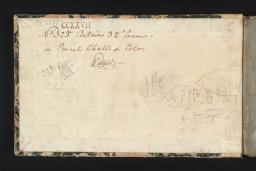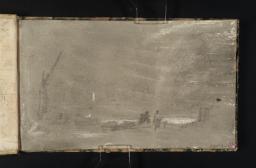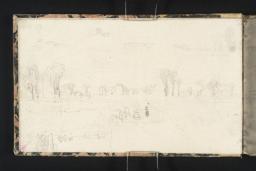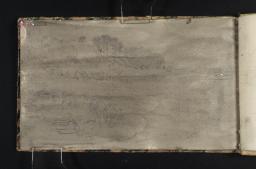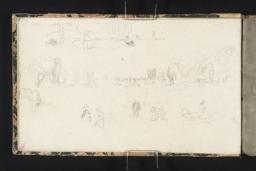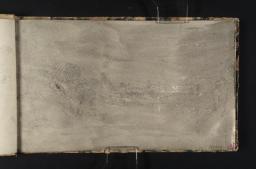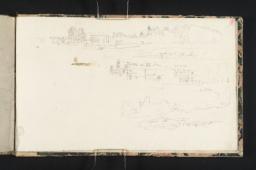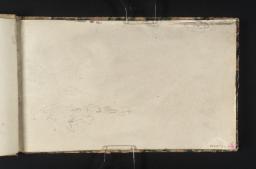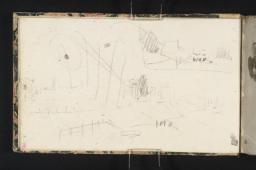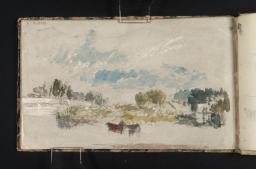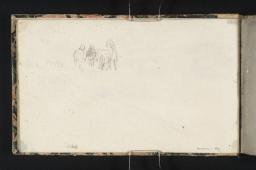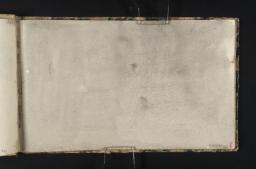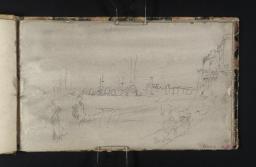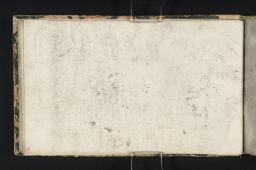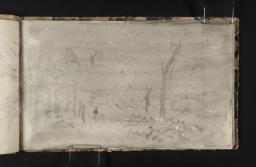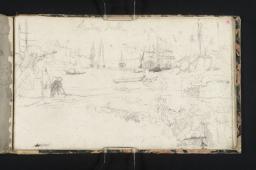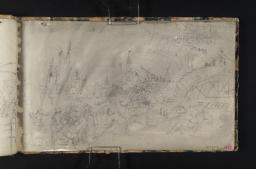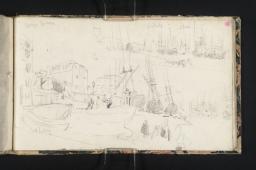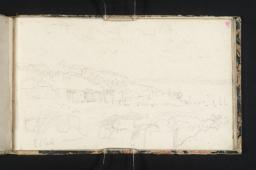Turner Bequest CCXXVII 1–43
Sketchbook bound in boards, quarter-bound in grey and buff marbled paper covers over buff parchment spine
43 leaves and paste-downs of white wove paper, the rectos prepared with a grey wash; page size 110 x 185 mm; watermark ‘J & R Ansell | 1817’
Inscribed by Turner in ink ‘Wight’ on spine (D41004)
Numbered 323 as part of the Turner Schedule in 1854 and endorsed by the Executors of the Turner Bequest, Charles Turner, Charles Lock Eastlake and John Prescott Knight, inside front cover (D41005)
Blind-stamped with Turner Bequest monogram towards top left
Stamped in black ‘CCXXVII’ top right
43 leaves and paste-downs of white wove paper, the rectos prepared with a grey wash; page size 110 x 185 mm; watermark ‘J & R Ansell | 1817’
Inscribed by Turner in ink ‘Wight’ on spine (D41004)
Numbered 323 as part of the Turner Schedule in 1854 and endorsed by the Executors of the Turner Bequest, Charles Turner, Charles Lock Eastlake and John Prescott Knight, inside front cover (D41005)
Blind-stamped with Turner Bequest monogram towards top left
Stamped in black ‘CCXXVII’ top right
Accepted by the nation as part of the Turner Bequest 1856
Exhibition history
References
This sketchbook combines views on or around the Isle of Wight, apparently made in the late summer of 1827, with scenes along the River Thames both around London Bridge and upriver in the rural Thames Valley to the west, possibly dating from shortly beforehand,1 and dated here to c.1827. On account of the Isle of Wight subjects, the book has been catalogued with the contemporary Cowes Regatta and Windsor and Cowes, Isle of Wight sketchbooks (Tate; Turner Bequest CCVII, CCXXVI), which focus on the waters around Cowes and East Cowes, with many studies of shipping relating to the 1827 regatta events. As discussed in the Introduction to this tour, Turner’s host, the architect John Nash of East Cowes Castle, had commissioned two paintings, which would come to be exhibited at the Royal Academy in 1828, East Cowes Castle, the Seat of J. Nash, Esq.; the Regatta Beating to Windward (Indianapolis Museum of Art)2 and East Cowes Castle, the Seat of J. Nash, Esq.; the Regatta Starting for their Moorings (Victoria and Albert Museum, London),3 but nothing in the present book relates to them as such.
Indeed, the drawings are somewhat miscellaneous both in their subjects and in their degree of finish, many being slight or very rapidly set down. The Thames subjects are comparable with those in several other sketchbooks of about the same period, addressed in the present author’s ‘Thames, London and South of England 1821–7’ section of this catalogue; its Introduction discusses Turner’s continued depiction of long-familiar river scenes, following on from those in David Blayney Brown’s ‘Thames sketchbooks c.1804–14’ section. Two key drawings show the ongoing construction of the new London Bridge (folios 12 recto, 34 verso; D20751, D20784; Turner Bequest CCXXVII 12, 32a), at the stage depicted by other artists in works of 1827; for other central London views here, see under folio 10 verso (D20748). There are also numerous studies up and down the Thames about fifteen miles south-west of London Bridge in the vicinity of Hampton Court Palace, a subsequent watercolour of which was engraved for Turner’s Picturesque Views in England and Wales in 1829; see under folio 2 verso (D20736). There are other Thameside England and Wales subjects of about the same date in the Windsor and Cowes, Isle of Wight book.
There are several views in and around Portsmouth, including prospects of the Isle of Wight to the south; see under folio 10 recto (D20747). The identifiable scenes on the island itself are largely of places away from Cowes and East Cowes, such as Ryde, towards the eastern end; for views there and other island scenes, see under folio 2 recto (D20735). An exception is a drawing of Cowes from the battlements of East Cowes Castle itself on folio 16 verso (D20757), which is perhaps the best evidence to link this sketchbook to 1827 and Turner’s stay at the house in particular. (See the introduction to the tour for discussion of the possibility of an Isle of Wight visit in 1826.)
There are a few watercolours of coastal views which appear to be of the island, but lacking specific landmarks, as well as some generic Thames Valley scenes (see under folio 5 recto; D20741). Gerald Wilkinson described them as having ‘great charm’,4 and their freshness and light touch were presumably necessitated by being worked over the grey wash with which the rectos had all been prepared (as discussed in the technical notes below) without disturbing the base tone.
Technical notes
How to cite
Matthew Imms, ‘Isle of Wight sketchbook 1827’, sketchbook, November 2015, in David Blayney Brown (ed.), J.M.W. Turner: Sketchbooks, Drawings and Watercolours, Tate Research Publication, November 2016, https://www

